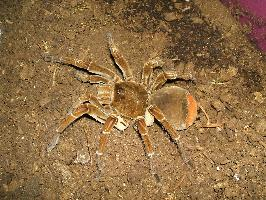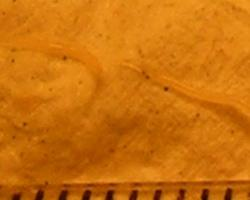
Popis zvířete
The Goliath Birdeater (Theraphosa blondi) stands as one of the most formidable and awe-inspiring arachnids within the animal kingdom. Native to the rainforest regions of northern South America, particularly in countries like Venezuela, Brazil, Guyana, and Suriname, this colossal spider has earned its name for being the largest spider in the world by mass and size. However, its common name, "birdeater," is somewhat of a misnomer as its diet seldom includes birds.Characterized by its hefty body and expansive leg span, the Goliath Birdeater can reach up to 30 centimeters (about 12 inches) across when its legs are fully extended, and it can weigh over 170 grams. The spider's body is covered in a dense layer of brownish hair, which serves multiple purposes, including sensory function and defense. When threatened, it can release these hairs from its abdomen, which are barbed and can cause irritation and discomfort to potential predators or humans.
The Goliath Birdeater possesses large fangs, which can grow up to an inch in length. Despite their intimidating appearance, their bite is not deadly to humans. The venom of the Goliath Birdeater is relatively harmless to humans, causing mild swelling and pain, akin to a wasp sting. However, their fangs are capable of piercing human skin, and their size alone can make an encounter with one an intimidating experience.
Primarily nocturnal, the Goliath Birdeater is a ground-dwelling spider that prefers the dense, humid environment of the rainforest floor. It constructs deep burrows for shelter, which it lines with silk. Its diet mainly consists of insects, but it is also known to consume larger prey such as frogs, lizards, and small mammals. Despite its name suggesting avian meals, bird consumption is rare and not a significant part of its diet.
Reproduction is a perilous time for male Goliath Birdeaters, as females are known to exhibit cannibalistic tendencies post-mating. Males must approach females with caution and often perform a series of vibrations or dances to pacify the female before copulation. Females lay eggs in a silk sac, producing up to 200 eggs, which she fiercely guards until they hatch.
The Goliath Birdeater communicates and senses its environment through vibrations. It lacks good eyesight, relying instead on the sensitive hairs that cover its body to detect movement around it. These hairs can pick up on the slightest vibrations in the air or on the ground, allowing it to effectively navigate and hunt in the darkness of its habitat.
Despite its fearsome reputation, the Goliath Birdeater plays a crucial role in the ecosystem. As a predator, it helps control populations of insects and other small animals, contributing to the balance of its rainforest home. For those fascinated by the natural world, the Goliath Birdeater embodies the incredible diversity and adaptability of life on Earth, serving as a remarkable example of the evolutionary wonders that inhabit our planet.
Podobná zvířata
Nové fotografie zvířat
Top 10 zvířat
- Common cockchafer (Melolontha melolontha)
- Common house mosquito (Culex pipiens)
- Colossal squid (Mesonychoteuthis hamiltoni)
- Giant house spider (Eratigena atrica)
- Harpy eagle (Harpia harpyja)
- Fruit fly (Drosophila melanogaster)
- Common reed warbler (Acrocephalus scirpaceus)
- Australian box jelly (Chironex fleckeri)
- Proboscis monkey (Nasalis larvatus)
- Moustached guenon (Cercopithecus cephus)


